|
ULA EQUIPMENT OHM BACKPACK
TEST SERIES BY NANCY GRIFFITH
LONG-TERM REPORT
INITIAL REPORT - April 02, 2010
FIELD REPORT - July 01, 2010
LONG TERM REPORT - August 26, 2010
TESTER INFORMATION
|
NAME:
|
Nancy Griffith
|
|
EMAIL:
|
bkpkrgirlATyahooDOTcom
|
|
AGE:
|
44
|
|
LOCATION:
|
Northern California, USA
|
|
GENDER:
|
F
|
|
HEIGHT:
|
5' 6" (1.68 m)
|
|
WEIGHT:
|
130 lb (59.00 kg)
|
My outdoor experience began in high school with involvement in a local canoeing/camping group called Canoe Trails. The culmination was a 10-day canoe voyage through the Quebec wilds. I've been backpacking since my college days in Pennsylvania. I have completed all of the Appalachian Trail in Georgia, Tennessee and North Carolina. My typical trip now is in the Sierra Nevada in California and is from a few days to a week long. I carry a light to mid-weight load, use a tent, stove and hiking poles.
INITIAL REPORT
PRODUCT INFORMATION & SPECIFICATIONS
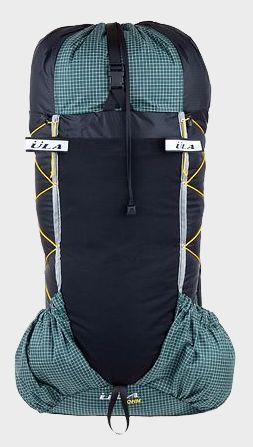 | | Photo courtesy of ULA Equipment website |
Manufacturer: Ultralight Adventure Equipment
Year of Manufacture: 2010
Manufacturer's Website: http://www.ula-equipment.com
MSRP: $175 US
Listed Weight: 21 oz (595 g) without options (in size Torso Medium, Hip belt Medium)
Listed Weights of Options:
Hip belt Pockets (qty 2): 1.2 oz (34 g)
Hand Loops (qty 2): 0.8 oz (22 g) for both
Hydration Sleeve: 1.4 oz (40 g)
Internal Mesh Pocket: 1.1 oz (31 g)
Water Bottle Holsters (qty 4): 0.8 oz (22 g)
Internal Back Pad: Not Listed
Measured Weight: 27 oz (765 g) with all options (in size Torso Medium, Hip belt Medium)
Measured Weight of Options:
Hip belt Pockets (qty 2): 1.1 oz (31 g) each
Hand Loops (qty 2): 0.4 oz (11 g) each
Hydration Sleeve: 1.2 oz (34 g)
Internal Mesh Pocket: 1.0 oz (28 g)
Water Bottle Holsters (qty 4): 0.2 oz (5 g) each
Internal Back Pad: 1.2 oz (34 g)
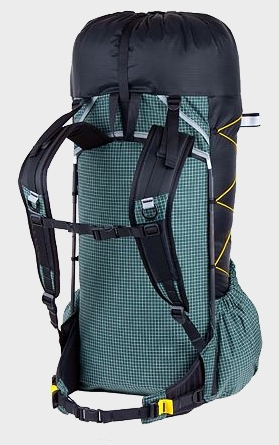 | | Photo courtesy of ULA Equipment website |
Listed Total Capacity: 3,560 cu in (58 L)
Main Compartment: 2,100 cu in (34 L)
Front Mesh Pocket: 500 cu in (8 L)
Side Pockets (qty 2): 400 cu in (6.5 L) each
Extension Sleeve: 500 cu in (8 L)
Hip belt Pockets (qty 2): 30 cu in (0.5 L)
Ohm Pack Torso Length Guide:
Medium: 18 - 21 in (46 - 53 cm)
Large: 21 - 23 in (53 - 58 cm)
My torso length: 19 in (48 cm)
Ohm Pack Waist Belt Guide:
Medium: Less than or equal to 33 in (84 cm)
Large: Greater than 33 in (84 cm)
My waist size: 29 in (74 cm)
Recommended Maximum Load: 30 lb (13.6 kg) or less
Recommended Base Weight: 12 lb (5.4 kg) or less
Made in USA (Logan, Utah)
PRODUCT DESCRIPTION
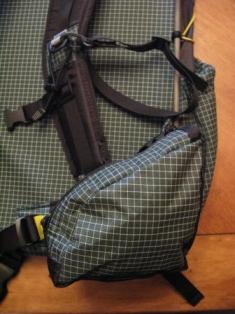 The ULA Equipment Ohm backpack is a full-featured ultralight pack. The sides and front of the main compartment (the black sections) are made of 1.9 oz (54 g) ripstop nylon. The back panel and lower portion (checkered green sections) are made of a Dyneema Gridstop material. The ULA Equipment Ohm backpack is a full-featured ultralight pack. The sides and front of the main compartment (the black sections) are made of 1.9 oz (54 g) ripstop nylon. The back panel and lower portion (checkered green sections) are made of a Dyneema Gridstop material.
The main compartment is 2,100 cu in (34 L) with a 500 cu in (8 L) extension sleeve. There is a drawstring closure with a cord lock. Any unused portion can be rolled down and secured with a compression strap which runs from front to back. Along the length of the front is a stretchy mesh pocket. At the bottom of both sides of the pack are pockets with non-adjustable elasticized tops. Along both sides above the pockets are non-stretch compression cords which are laced in a zigzag pattern and secured with a cord lock.
The padded shoulder straps are contoured to allow for arm movement. The height of the sternum strap can be adjusted by moving it vertically to a comfortable position. The hip belt is padded and contoured and has two (one on each side) removable pockets with zippered closures. The pack can be adjusted at the shoulders with load lifter adjustment straps and at the hip belt with load stabilizer straps. There is a strap loop for lifting the pack.
Attached to the shoulder straps are removable hand loops which can be adjusted for length. These can be used to rest my hands in cases where I am not using trekking poles. Also attached to the shoulder straps (in an upper and lower location) are two sets of water bottle holsters. The upper strap loops around the top of a bottle while the lower straps loops around the bottom of the bottle. Both are secured with a cord lock. The instructions recommend use with a tall bicycle style bottle with neck or Aquafina bottle and specifically do not recommend use with a Nalgene or Gatorade bottle.
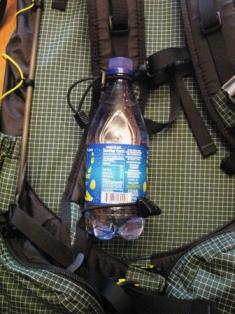
The most unique feature is a 1.2 oz (34 g) carbon-fiber/delrin active suspension hoop which is attached to the back in an upside-down U shape. It is to transfer load from shoulders to hips.
There is an ice axe loop at the lower part of the front and two hook-and-loop pole retention straps at the upper part of the front which have the ULA logo on them.
Inside the pack is a removable hydration sleeve. There are openings at the top of the pack on either side for routing the tube of a hydration reservoir. There are tags at these locations to make them easy to find. At the back is a removable back pad with two angled sections of elastic to hold it in place. A sleeping pad can also be folded and placed in this area for additional back support. Also inside the pack but near the front is a removable mesh pocket which may be used as a trail wallet or for storing smaller items.
READING THE INSTRUCTIONS
There were two sheets of information included which notes that pack loads should not exceed 30 lb (14 kg) and are best kept around 20 to 25 lb (9 to 11 kg). There are tips about how to load a backpack with a recommendation to use a sleeping pad as additional load support at the back. It explains how to put the pack on and adjust all of the straps. Finally there is a section about each of the pack options and how to use them.
INITIAL IMPRESSIONS & TRYING IT OUT
When the package arrived, I was impressed by how small and light the box was with the pack inside. Overall it was what I was expecting based on their website except that I thought the color would be blue while the pack I received was green. The color is of no concern to me and I actually prefer the green color. When I went back to the website, I could see that it is green and suppose that the checkered pattern made me correlate it with blue.
The optional pockets and straps, while being securely attached to the pack were easy to remove and replace. I wasn't sure how the water bottle holsters and hand loops worked (or what they were) until I read the information included. I really like the number of pockets for such a light pack. The two external side pockets are large, while the optional hydration sleeve, internal mesh pocket and hip belt pockets provide many options for easy organization, or can be removed for keeping the pack's weight down.
I love that I am given the choice of whether I need or want to use the options on any given trip. I was extremely impressed that the given weight of the pack on the website was so accurate. In fact I found it to be exactly correct for total weight minus the options if I included the 'optional' back pad. So, they actually underestimated a bit or assumed that most people will use the back pad.
The pack seems to be very well-constructed. All of the seams are solid and every area seems very sturdy. The fabric, while lightweight, doesn't give me the impression of something easily worn or torn, but I'll have to see how things hold up in the field.
The waist size for a Medium hip belt is less than 33 in (84 cm). Although my waist is several inches smaller than this, there is plenty of adjustment to get a snug fit on my hips.
SUMMARY
The Ultralight Adventure Equipment backpack is lightweight while maintaining some great features such as pockets and straps that are often excluded from ultra-light packs.
Initial Likes:
Light weight (and accurate manufacturer's weight!)
Optional pockets and straps are removable
Quality construction
Initial Dislikes:
None
FIELD REPORT
FIELD LOCATIONS AND CONDITIONS
Over the Field Testing period, I used the pack for 3 backpacking trips and 2 day hikes for a total of 9 days. One trip was a snowshoe backpack in deep spring snow while the others were more typical backpacking.
Snow Camping in 7 to 9 ft (2 to 3 m) of snow pack:
Loon Lake, Van Vleck Trail, Sierra Nevada, California; 6 mi (10 km); 6,327 to 7,000 ft (1,928 to 2,134 m); 28 to 55 F (-2 to 13 C); clear with some windy conditions; 24 lb (11 kg)
Backpacking:
Western States Trail, Sierra Nevada, California; 3 days; 18 mi (30 km); 1,800 to 4,365 ft (549 to 1,330 m) elevation; 45 to 72 F (7 to 22 C); clear to partly cloudy to light rain conditions; pack weight 24 lb (11 kg)
Mumford Bar Trail, Sierra Nevada, California; 2 days; 13 mi (21 km); 2,640 to 5,360 ft (805 to 1634 m) elevation; 53 to 90 F (12 to 32 C); clear conditions; pack weight 23 lb (10 kg)
Day Hiking:
Western States Trail, Sierra Nevada, California; 5 mi (8 km); 3,520 to 1,820 ft (1,073 to 555 m) elevation; cloudy to light rain conditions; pack weight 15 lb (7 kg)
Bake Oven Trail, Sierra Nevada, California; 10 mi (16 km); 1,630 to 3,520 ft (497 to 1,073 m); 65 to 80 F (18 to 27 C); clear to partly cloudy conditions; 15 lb (7 kg)
PERFORMANCE IN THE FIELD
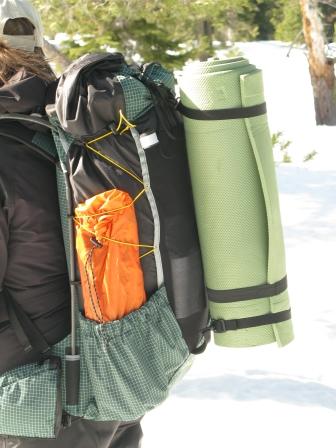
Loading the Pack:
For our snow camping trip, I carried a bulkier load than normal due to needing extra clothes, dry bag, the heavier tent, extra foam pad and more fuel for melting snow. While first packing it seemed that I was filling the pack to capacity. It all fit in quite well and I didn't have any trouble closing the top although it was quite full. On the next two backpacking trips, my pack contents fit in easier. As recommended I tried to pack things vertically so that the pack could be compressed from the sides. There was quite a bit of room to compress which made a nice solid pack for balance. On the day hikes I had odd loads of chairs, sandals, lunch, extra clothes and other miscellaneous items but by packing things vertically I was able to compress everything into a comfortable arrangement.
I folded my insulated air mattress sleeping pad and secured it in the back as additional back support along with the foam pad that came with the pack. On the day hikes, I did not use my air mattress as back support and only used the thin foam pad. I did not notice any reduction in support and didn't even realize that I had forgotten to use it until after the hikes.
Straps and Pockets:
On the snow trip, I strapped the foam pad on the outside using the hand straps. They fit around the rolled pad and then I clipped the hand straps to the ice axe strap and top closure strap. It worked well since the pad is quite light and didn't throw off the load balance. I backpack and hike with trekking poles, so I did not use the hand straps for resting my hands.
I found that the hip pockets hold an amazing amount of stuff. I typically store small items in my pants pockets but I was wearing shorts (with no pockets) on the snow-camping trip. Yes, the hike was warm! I took all of those small items and fit them easily into the two hip pockets. Here is an example of how much fits into just ONE of the hip pockets without overstuffing it. The hip pockets were easy to access and the zipper easy to operate while hiking. 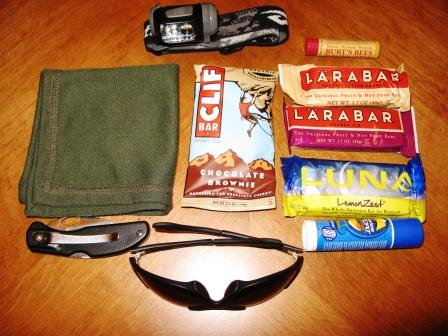
I used the hydration reservoir pocket and found it very easy to route the drinking tube through the slot in the pack. I found that my 2 liter (70 oz) water reservoir is a bit smaller than the pocket so it would slide down to the bottom. This allowed the contents of my pack to shift over the reservoir which then allowed the tube to become restricted. I am thinking of stapling the pocket near the bottom to make it a bit shorter and to better fit my reservoir. The water bottle holder straps were helpful for keeping my mouthpiece from flopping onto the ground. I also used them for hanging my watch. I did not use them for water bottles.

I used the mesh pocket as a wallet for my (and my husband's) drivers license, credit card, fishing license and cash. It was fairly easy to keep it out of my way while packing by flipping it over toward the outside of the pack. Then when I finished packing, I simply flipped it back over on top of the pack contents. It worked fine, but I didn't really see the need for this special pocket nor for having it in such a prominent location since I don't need my wallet while backpacking. I typically use a zip-top plastic bag which I tuck into a corner of my pack to keep it out of the way.
I used the outer mesh pocket for drying clothing that I had washed in camp and wasn't quite dry by the time we were leaving camp. Clothing continued to dry in the pocket and I really like having this option rather than hanging laundry off of my pack. I also used it for keeping my sun hat and a magazine. The pocket is the exact size as the width of a magazine so it fit perfectly without extra slop from side-to-side.
The two side pockets are very large and the elastic at the top kept my contents secure. I used them for fishing rods, fishing lures, insect repellent, toilet paper, a map and a folding chair. All of these contents fit well, were easy to access and were easy to secure to the pack. These are the first backpack side pockets that I can actually reach by myself.
Fit and Comfort:
During my hikes, I like to alternate between carrying most of the weight on my shoulders to carrying it on my hips. I noticed that the padding on the hip belt was limited and seemed to end right at my hip bone. This made my hip bone get really sore over the miles and by the next day it felt bruised when I tightened the hip belt against it again. The shoulder straps were comfortable and didn't cause any discomfort.
In general I found the torso length to be a bit long for me despite being mid-range for the medium size. I had trouble having enough adjustment length. I ended up with the shoulder straps fully extended and still had the shoulder strap above my shoulder.
Durability:
The pack seems to have good durability. There were several times that I squeezed through downed trees, branches and bushes which brushed against the pack. I cannot see any evidence of snags or damage on the pack. The straps, buckles and shock-cord are completely intact and in like-new condition.
SUMMARY
The ULA Equipment Ohm backpack is a very lightweight pack with a ton of features. I was pleasantly surprised at how well it functioned in the field.
GREAT:
Lightweight
Hip pocket volume
Ability to reach side pockets
Durability
Extra pockets and extra straps are removable
Not so great:
Hip belt does not extend over my hip bone
Don't see the need for the wallet pocket, but I'm glad that it is removable
LONG-TERM REPORT
LONG-TERM TEST LOCATIONS AND CONDITIONS
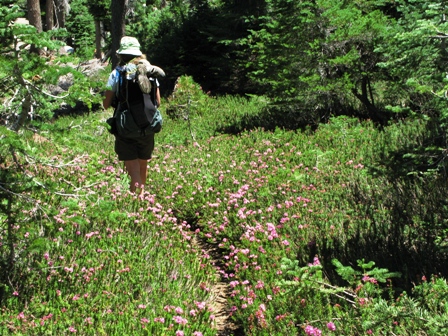 Over the Long-Term Testing period, I used the pack for two backpacking trips of 5 days total, 3 day hikes and one boat camping trip. Over the Long-Term Testing period, I used the pack for two backpacking trips of 5 days total, 3 day hikes and one boat camping trip.
Backpacking:
Desolation Wilderness, Sierra Nevada, California; 3 days; 19.5 mi (31.4 km); 6,560 to 8,220 ft (2,000 to 2,505 m) elevation; 40 to 80 F (4 to 27 C); 23 lb (10.4 kg) load
Desolation Wilderness, Sierra Nevada, California; 2 days; 12.6 mi (20.3 km); 6,560 to 8,220 ft (2,000 to 2,505 m) elevation; 48 to 80 F (9 to 27 C); 20 lb (9 kg) load
Hiking:
Rockbound Lake, Desolation Wilderness, Sierra Nevada, California: 9 mi (14.5 km); 6,200 to 6,900 ft (1,890 to 2,103 m) elevation; 60 to 75 F (16 to 24 C); 15 lb (6.8 kg) load
Forni Lake, Desolation Wilderness, Sierra Nevada, California: 10 mi (16.1 km); 6,600 to 7,100 ft (2,012 to 2,164 m) elevation; 70 to 80 F (21 to 27 C); 13 lb (5.9 kg) load
Forni Lake...again, Desolation Wilderness, Sierra Nevada, California: 10 mi (16.1 km); 6,600 to 7,100 ft (2,012 to 2,164 m) elevation; 70 to 85 F (21 to 29 C); 15 lb (6.8 kg) load
Boat Camping:
Loon Lake, Sierra Nevada, California; 4 days; 6,200 ft (1,890 m); 50 to 75 F (10 to 24 C). I used the pack for hauling camping gear in the boat and for carrying it to camp from the boat.
PERFORMANCE IN THE FIELD
I used my folded insulated air mattress sleeping pad in the back as additional back support for all trips during this period. I like the additional support and padding but it also made a convenient place to carry my sleeping pad.
Straps and Pockets:
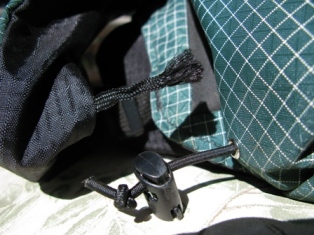 I just LOVE the hip pockets because they hold so much and are very convenient. I can access my sunscreen, lip balm, snacks, etc. all while continuing down the trail. The zippers are easy to operate while walking. The only problem that I had was that the small strap that holds the hip pocket down against the main part of the pack detached on one pocket. This allowed the pocket to dangle loosely away from the pack. I simply threaded it back through the cord lock which holds it in place but it isn't as secure as it was. I once had an animal eat one of my bars from my hip pocket while I left it unattended. However, there was no damage to the pocket since I must have had the pocket open slightly. I just LOVE the hip pockets because they hold so much and are very convenient. I can access my sunscreen, lip balm, snacks, etc. all while continuing down the trail. The zippers are easy to operate while walking. The only problem that I had was that the small strap that holds the hip pocket down against the main part of the pack detached on one pocket. This allowed the pocket to dangle loosely away from the pack. I simply threaded it back through the cord lock which holds it in place but it isn't as secure as it was. I once had an animal eat one of my bars from my hip pocket while I left it unattended. However, there was no damage to the pocket since I must have had the pocket open slightly.
I continued to use the hydration pocket for my 70 oz (2 L) reservoir. The only problem that I had with it is that I would load my water in first and then remember that I need to load the sleeping pad in the back under the water reservoir. I ended up just leaving my sleeping pad in the pack between trips. I used the water bottle straps for routing my hydration reservoir tube. The lower one worked great for keeping the tube from bouncing as I walked.
I continued to use the mesh pocket as a wallet and also used it for my iPod, headlamps and any smaller items that would migrate to the bottom of my pack. The pocket kept these smaller things protected and easy to find.
I also really like the two side pockets because I can reach them myself without any great contortion. They hold items securely due to their large size and the elastic top. I used them for toilet paper, maps, fishing rods, fishing lures, insect repellent and sunscreen.
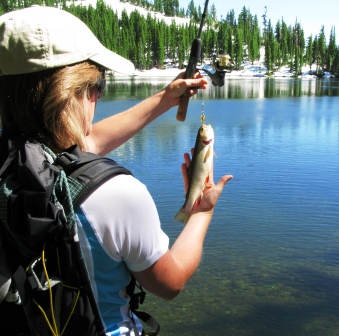 Fit and Comfort: Fit and Comfort:
I didn't notice the discomfort to my hips during this test period that I had felt during the Field Test period. I'm not sure I became used to the pack more or if I had it adjusted differently but I had a similar pack weight. I found the pack to be very comfortable on day hikes. I even left it on for the entire time that we fished around the circumference of Forni Lake. There was still a lot of snow on the banks, so it was easiest to walk in the water and to leave my pack on.
The compression straps on either side of the pack work nicely for maintaining a well-balanced load. It's new to me to pack vertically like that, but once I got the hang of it, I really liked it. I just put a tall item in first (like a tent or tent poles) and then stacked other items to that same height and used the straps to pull in the sides as much as necessary. Even on the day hikes with oddly shaped gear, I was able to make a secure load.
Durability:
The only durability issue I had was with the small strap on the back of the hip pocket coming detached from the pocket. Otherwise, the pack looks as good as new despite being brushed against trees and rocks throughout the test. All of the straps, zippers, buckles and cord locks work fine.
SUMMARY
The ULA Equipment Ohm backpack is a very lightweight pack with some great features. I found it to be comfortable for the typical load that I carry.
GREAT:
Lightweight
Hip pocket volume
Ability to reach side pockets
Some pockets and straps are removable
Compression straps on the sides
Not so great:
The strap broke on the hip pocket
This concludes my Long-Term Report and this test series. Thanks to ULA Equipment and BackpackGearTest.org for allowing me to participate in this test.
This report was created with the BackpackGearTest.org Report Writer Version 1.5
Copyright 2010. All rights reserved.
Read more gear reviews by Nancy Griffith
|




